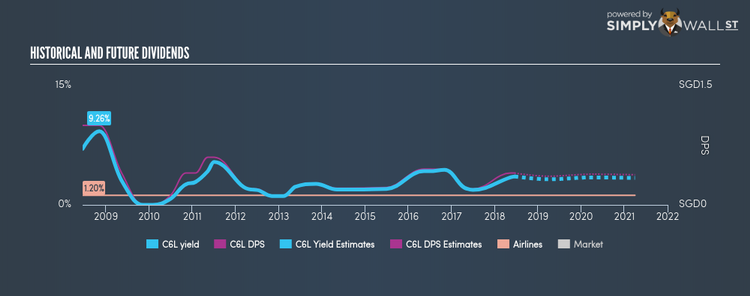Should Singapore Airlines Limited (SGX:C6L) Be Part Of Your Portfolio?

A large part of investment returns can be generated by dividend-paying stock given their role in compounding returns over time. Singapore Airlines Limited (SGX:C6L) has returned to shareholders over the past 10 years, an average dividend yield of 3.00% annually. Should it have a place in your portfolio? Let’s take a look at Singapore Airlines in more detail. Check out our latest analysis for Singapore Airlines
5 questions to ask before buying a dividend stock
When researching a dividend stock, I always follow the following screening criteria:
Does it pay an annual yield higher than 75% of dividend payers?
Has it paid dividend every year without dramatically reducing payout in the past?
Has the amount of dividend per share grown over the past?
Is its earnings sufficient to payout dividend at the current rate?
Will the company be able to keep paying dividend based on the future earnings growth?
Does Singapore Airlines pass our checks?
The company currently pays out 52.98% of its earnings as a dividend, according to its trailing twelve-month data, meaning the dividend is sufficiently covered by earnings. In the near future, analysts are predicting lower payout ratio of 44.75%, leading to a dividend yield of around 3.34%. However, EPS should increase to SGD0.77, meaning that the lower payout ratio does not necessarily implicate a lower dividend payment. Reliablity is an important factor for dividend stocks, particularly for income investors who want a strong track record of payment and a positive outlook for future payout. Not only have dividend payouts from Singapore Airlines fallen over the past 10 years, it has also been highly volatile during this time, with drops of over 25% in some years. These characteristics do not bode well for income investors seeking reliable stream of dividends. Relative to peers, Singapore Airlines generates a yield of 3.57%, which is high for Airlines stocks but still below the market’s top dividend payers.
Next Steps:
Whilst there are few things you may like about Singapore Airlines from a dividend stock perspective, the truth is that overall it probably is not the best choice for a dividend investor. But if you are not exclusively a dividend investor, the stock could still be an interesting investment opportunity. Given that this is purely a dividend analysis, I urge potential investors to try and get a good understanding of the underlying business and its fundamentals before deciding on an investment. Below, I’ve compiled three relevant factors you should look at:
Future Outlook: What are well-informed industry analysts predicting for C6L’s future growth? Take a look at our free research report of analyst consensus for C6L’s outlook.
Historical Performance: What has C6L’s returns been like over the past? Go into more detail in the past track record analysis and take a look at the free visual representations of our analysis for more clarity.
Dividend Rockstars: Are there better dividend payers with stronger fundamentals out there? Check out our free list of these great stocks here.
To help readers see pass the short term volatility of the financial market, we aim to bring you a long-term focused research analysis purely driven by fundamental data. Note that our analysis does not factor in the latest price sensitive company announcements.
The author is an independent contributor and at the time of publication had no position in the stocks mentioned.

 Yahoo Finance
Yahoo Finance 
